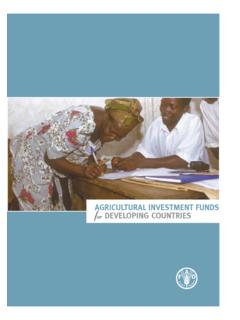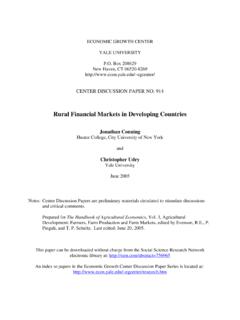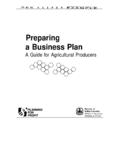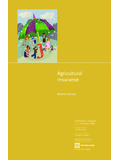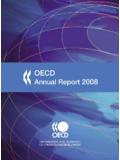Transcription of Food and agriculture organization oF the united nations
1 food and agriculture organization oF the united nationsrome, 2013rauno zander, calvin miller and nomathemba mhlangaRecommended citationFAO. 2013. Credit guarantee systems for agriculture and rural enterprise development. photograph FAO/Giulio NapolitanoThe designations employed and the presentation of material in this information product do not imply the expression of any opinion whatsoever on the part of the food and agriculture organization of the united nations (FAO) concerning the legal or development status of any country, territory, city or area or of its authorities, or concerning the delimitation of its frontiers or boundaries.
2 The mention of specific companies or products of manufacturers, whether or not these have been patented, does not imply that these have been endorsed or recommended by FAO in preference to others of a similar nature that are not views expressed in this information product are those of the author(s) and do not necessarily reflect the views of 978-92-5-107412-1 All rights reserved. FAO encourages reproduction and dissemination of material in this information product. Non-commercial uses will be authorized free of charge, upon request.
3 Reproduction for resale or other commercial purposes, including educational purposes, may incur fees. Applications for permission to reproduce or disseminate FAO copyright materials, and all queries concerning rights and licences, should be addressed by e-mail to or to the Chief, Publishing Policy and Support Branch, Office of Knowledge Exchange, Research and Extension, FAO, Viale delle Terme di Caracalla, 00153 Rome, Italy. FAO 2013iiiContentsPreFace viexecutive summary viiacknowledgements ixacronyms xchaPter 1 Background and introduction 1 Background 1target audience 1rationale and purpose 1structure of the document 2chaPter 2 Credit guarantees what we know 5overview 5actors
4 6types of guarantee 6regional coverage of credit guarantee systems 7history and prevalence of guarantee systems 7earlier studies and reference material 9the case for credit guarantees 10the pitfalls of credit guarantees 13selected institutional models 15stocktaking the regional experience 18the regulatory framework for credit guarantees 28chaPter 3 Case examples from developing country experience 31latin american experience Fideicomisos Instituidos en Relaci n con la Agricultura, mexico 32asian experience credit guarantee fund trust for micro and small enterprises, india 35african experience agricultural credit guarantee scheme fund , nigeria 39eastern european experience rural development Foundation.
5 Estonia 41ivOther case examples 44 Comparison of key indicators 45 CHAPTER 4 Emerging trends and approaches 49 The vital role of applied research and scientific empirical studies 49 Individual versus portfolio guarantees 50 Commercialization of loan guarantee funds 51 Ownership and governance 52 Innovations and potential future growth areas for loan guarantees 52 CHAPTER 5 Recommendations for policy dialogue, formulation and advice 55 Key lessons on the sustainability of credit guarantee systems 55 Implications for policy development the study hypotheses 57 Implications for capacity building 62 Recommendations 63 Remaining questions and challenges 64 ANNExEs1 summary of FAO case studies on guarantee funds 652 Case study term sheets of agricultural guarantee funds 693 summary evaluation of UNIDO s experience with guarantee funds 103
6 REFERENCEs 105 BOxEs1 Top five key factors for MsME growth 11 TABlEs1 FIRA and associated trust financial products, by term and sector 332 FIRA key design indicators 353 FIRA key performance indicators 354 Claim settlements by the CGTMsE trust, 2005 to 2010 395 CGTMsE key design indicators 406 CGTMsE key performance indicators 407 ACGsF income and expenditure statement, 2006 to 2009 (NGN) 418 ACGsF key design indicators 429 ACGsF key performance indicators, at end of 2009 4210 RDF guarantees, by business area, first six months of 2011 4311 RDF key design indicators 4412 RDF key performance indicators, end 2010 4413 Categories of end borrower covered by guarantees 4714 Research hypotheses and recommendations 58vFIGUREs1 FEGA s guaranteed loans (MxN billion, December 2010) 342 CGTMsE system, India 363 CGTMsE trust fund composition 384 Types of guarantee offered 455 Maximum guarantee coverage (percentages)
7 46viPrefaceGuarantee funds have been used over the years in many countries, forms and contexts as a way to increase the flow of funds into targeted sectors and groups. Various types of guarantee systems and scheme are used to make lending more attractive by sharing or absorbing the risks associated with lending to the targeted sector or type of enterprise. Such systems can also increase the amount of loan funds available to an enterprise beyond its own collateral limits, because the guarantee is a form of loan collateral.
8 The guarantee manager can assume the additional role of loan assessor and monitor, which can improve the quality of the loans made. However, guarantee funds have a cost, which is paid through the fees charged and/or subsidized by the government or a donor. Questions arise regarding the cost versus the benefits when a subsidy is needed. What is the value added of guarantee funds in reducing interest rates or the risks to lending, and how much do the funds influence lenders decision-making regarding whether or not to lend?
9 Guarantee funds have more frequently been used for small enterprise loans in diverse sectors, but they are now quite common in agriculture and agribusiness. There is renewed interest in using them to increase investment into the sector and to ensure that investment is directed towards target groups and agro-industries that are deemed too risky for adequate financing without such risk-sharing incentives. This document takes a fresh and unbiased look at the application and results of guarantee funds for agricultural and rural enterprise development.
10 Through analysis of guarantee funds that have been operational for a long time, the document aims to inform development agencies and policy-makers on current practices and experiences, so that they can apply this information to their decision-making regarding whether or not and/or how best to promote guarantee mechanisms that are effective and document builds upon four major case studies of guarantee funds and 12 other analyses of such funds. A detailed description of the four cases will also be published and available at summary Partial credit guarantees are a comparatively new instrument in agricultural development finance.










